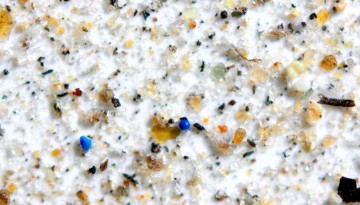The Shape Matters: Microplastics’ Atmospheric Travel Linked to Particle Morphology
Just like the land and the ocean, the atmosphere is marred by a variety of pollutants. In recent years, a new form has been identified: micron-size microplastic debris that can be carried by the jet stream across oceans and continents.
A Cornell collaboration has developed a model to simulate the atmospheric transport of microplastic fibers and found that their shape plays a crucial role in how far they travel. While previous studies assumed these fibers to be spherical, the research shows that flat fibers are more prevalent and travel farther in the lower atmosphere.
The modeling has the potential to help scientists determine the sources of the pervasive waste – which could inform policy efforts to reduce it.
The group’s paper, “Long-Distance Atmospheric Transport of Microplastic Fibres Influenced by Their Shapes,” published Sept. 25 in Nature Geoscience. The lead author is former postdoctoral researcher Shuolin Xiao.
Atmospheric microplastics result from a range of sources, from shredded tires and road dust to soda bottles bobbing along in the ocean. If the plastic disintegrates or gets ground up, it can become tiny enough to be carried by the wind.
The project began when Qi Li, assistant professor in the Department of Civil and Environmental Engineering in Cornell Engineering and senior author of the paper, reached out to Natalie Mahowald, the Irving Porter Church Professor in Engineering. Li’s lab explores environmental fluid mechanics and hydrology, primarily as they relate to Earth’s lower atmosphere, and she was intrigued by Mahowald’s recent research, along with co-author Janice Brahney of Utah State University, into the movement of airborne microplastics. Li also consulted Donald Koch, professor in the Smith School of Chemical and Biomolecular Engineering, who had studied the fundamental fluid dynamics of how fibers settle in turbulence.
“I realized, with my postdoc, that the current global climate models have been assuming that the shape of these fibers are spheres,” Li said. “We do not have, to date, a computationally feasible way of representing the settling velocity of these elongated fibers.”
By combining Koch’s theoretical insights with the extensive measurement data Mahowald and Brahney had collected, Li and Xiao set out to create a more rigorous system of analysis.
The result was a theory-based settling velocity model that could incorporate large-scale climate models, which revealed two key findings. Essentially, by treating flat fibers as spherical or cylindrical shaped, prior studies had overestimated their rate of deposition. Factoring in the fibers’ flat shape means they spend 450% more time in the atmosphere than previously calculated, and therefore travel longer distances.
The researchers also found that flat fibers comprised the majority of the microplastic particles Mahowald and Brahney had collected.
In addition, the modeling suggests the ocean may play a larger role in emitting microplastic aerosols directly into the atmosphere than previously known, according to Li.
“We can now more accurately attribute the sources of microplastic particles that will eventually come to be transported to the air,” she said. “If you know where they’re coming from, then you can come up with a better management plan and policies or regulations to reduce the plastic waste. This could also have implications for any heavy particles that are transported in the lower atmosphere, like dust and pollen.”
Doctoral student Yuanfeng Cui was a co-author.
The research was supported by the National Science Foundation, and computational resources were provided by the National Center for Atmospheric Research.

